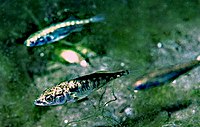
Photo from wikipedia
There is a general and solid theoretical framework to explain how the interplay between natural selection and gene flow affects local adaptation. Yet, to what extent coexisting closely related species… Click to show full abstract
There is a general and solid theoretical framework to explain how the interplay between natural selection and gene flow affects local adaptation. Yet, to what extent coexisting closely related species evolve collectively or show distinctive evolutionary responses remains a fundamental question. To address this, we studied the population genetic structure and morphological differentiation of sympatric three-spined and nine-spined stickleback. We conducted genotyping-by-sequencing and morphological trait characterisation using 24 individuals of each species from four lowland brackish water (LBW), four lowland freshwater (LFW) and three upland freshwater (UFW) sites in Belgium and the Netherlands. This combination of sites allowed us to contrast populations from isolated but environmentally similar locations (LFW vs. UFW), isolated but environmentally heterogeneous locations (LBW vs. UFW), and well-connected but environmentally heterogenous locations (LBW vs. LFW). Overall, both species showed comparable levels of genetic diversity and neutral genetic differentiation. However, for all three spatial scales, signatures of morphological and genomic adaptive divergence were substantially stronger among populations of the three-spined stickleback than among populations of the nine-spined stickleback. Furthermore, most outlier SNPs in the two species were associated with local freshwater sites. The few outlier SNPs that were associated with the split between brackish water and freshwater populations were located on one linkage group in three-spined stickleback and two linkage groups in nine-spined stickleback. We conclude that while both species show congruent evolutionary and genomic patterns of divergent selection, both species differ in the magnitude of their response to selection regardless of the geographical and environmental context.
Journal Title: Genes
Year Published: 2021
Link to full text (if available)
Share on Social Media: Sign Up to like & get
recommendations!